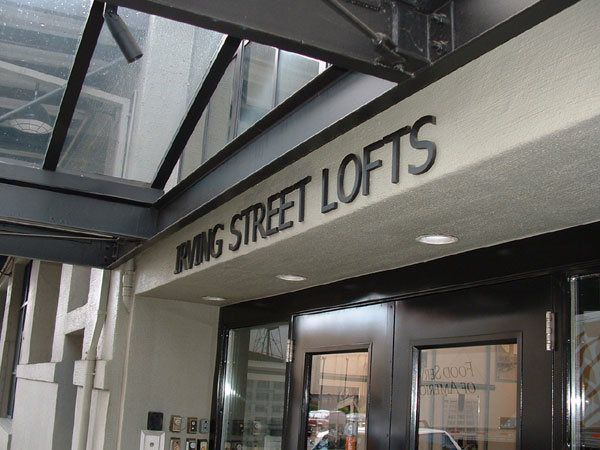OTHER BUILDINGS
IRVING STREET LOFTS
IRVING STREET LOFTS
PEARL DISTRICT
Irving Street Lofts...Irving Street Lofts is located at NW 13th and Irving Street with the address as 1314 NW. Irving Street. It's 8 stories with 86 lofts and is a converted 1924 industrial building. Building History: Irving Street Lofts building had 3 distinct phases: It was originally constructed as a warehouse in about 1925. The warehouse phase extended from construction until 1988 when the building was converted to apartments, also called Irving Street Lofts. The information provided here is from a document found in the on-site office files and its source is not known.
The apartment phase lasted from 1989 to 1995 when it the building was sold and the new owners converted it to condominiums. Warehouse Phase ISL was originally built in 1924-25 with an address of 630 NW 14th. Located in the Northwest 13th Avenue National Register Historic District, at 7 stories, it was the district’s tallest building (shared with the M&F warehouse) and a superior example of reinforced concrete construction. The Northwest 13th Avenue Historic District was comprised predominately of warehouses conveniently located off the 13th Avenue railroad spur line between Davis and Johnson. Originally residential in nature, the development of the area as a warehousing and distribution center arose as a result of railroad development spurred by Portland’s emergence as a world seaport, particularly following the city’s explosive growth after the 1905 Lewis & Clark Exposition. In 1937, the national pharmaceutical firm of McKesson & Robbins purchased the business, though the Frank family continued to own the property. In 1976, the building was sold to William Jewett. McKesson & Robbins began operations in New York City in 1833. Founded by John McKesson and Charles Olcott, the firm imported therapeutic drugs and chemicals for wholesale sales. In 1853, Olcott died and Daniel Robbins, a member of the firm, became a partner. In 1926, facing severe competition from Midwest-based pharmaceutical firms and heavy import tariffs, McKesson & Robbins sold its assets to Dr. F. Donald Coster. Coster revitalized the enterprise through aggressive marketing and innovative distribution schemes. He persuaded many of the regional wholesale drug distributors to become subsidiaries. With this network, McKesson & Robbins reached unprecedented sales of $140 million in 1929 with profits of $4.1 million. From the stock market crash of 1929 through the depression and prohibition, McKesson & Robbins survived. In 1933, with prohibition repealed, the company established a liquor distribution business. In 1939, it was discovered that Coster had embezzled $3 million from the firm through its “crude drug division” and that Coster’s real identify was Phillip Musica, a twice convicted business swindler. The discovery ultimately led to Coster committing suicide. Following World War II, McKesson & Robbins capitalized on America’s postwar needs by adapting wartime advances in synthetics and plastics for home use. Through the 1950s to the 1970s, the business continued to thrive. In 1967, they merged with Foremost Dairy to become Foremost-McKesson. Beginning in the 1980s, Foremost-McKesson reinvented itself, spinning off unprofitable enterprises (such as the dairy division) and became simply McKesson. As part of that effort, the company consolidated operations in the Portland area, vacating this building in 1981. The building remained vacant until the late 1980s when it was renovated into the Irving Street Loft apartments. (It should be noted that at the time of the conversion, a walkway/bridge which connected the ISL building with the Meyer and Frank warehouse, now known as the Avenue Lofts, across 14th to the west, was removed. There is a photo of that bridge in the lobby.) Conversion to condominiums started in early 1995. Apartment Phase The conversion from a warehouse to apartments occurred in 1988-89.
Condominium Phase :The building was sold to GranCorp Holdings, LLC in 1985 which immediately initiated the conversion to condominiums. As a part of the process, renters at the time were offered the opportunity to purchase and it is believed that many did (believed to be about 30%). It is believed that most units sold within a year's time.


